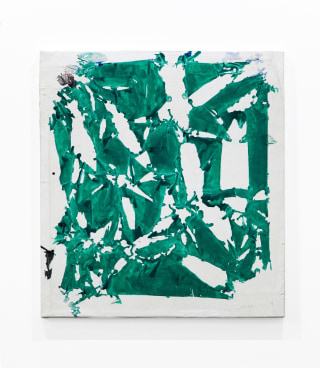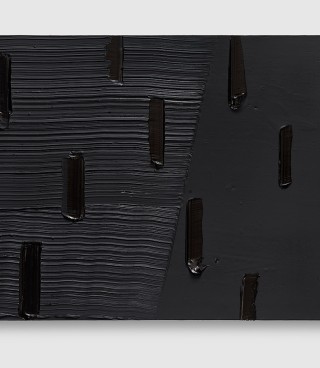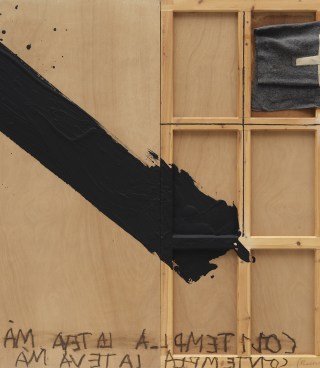Hantaï, Hartung, Soulages, Tàpies
This exhibition brings together the work of four artists who were instrumental in the evolution of post-war European abstraction, and looks at the different ways they invigorated their practice against the backdrop of an increasingly confident US cultural scene. Paris continued to be the nexus of European arts, literature and philosophy after the war, but it was clear that artists had to abandon the illusion that art could change society, and instead develop the notion of the artist as a liberated self-reliant individual. This impulse lead to painterly explorations with raw and unaesthetic materials and techniques, the use of paint as a flowing and vital medium and the use of impulsive and spontaneous lines and gestures.
The exhibition also touches on the question of longevity and how each of these artists sustained the project of abstraction over the period of half a century, breaking new ground again and again, and creating controversial and daring works well into the latter part of their careers. The exhibition explores techniques and materials used by these artists, from the intricate folded canvasses of Simon Hantaï, to the inventive dynamism of Hans Hartung, to the sensuous ‘ultrablack’ paintings of Pierre Soulages, to Antoni Tàpies’ materially complex tellurian landscapes.
Simon Hantaï (born Bia near Budapest 1922, died Paris 2008) was one of the most significant of post-war European artists, yet this is the first time his work has been exhibited in London. Hungarian born, he arrived in Paris in 1948 and soon attracted the attention of André Breton who arranged his first solo exhibition in 1953. Inspired by Pollock and Matisse, in 1960 he initiated his ‘pliage’ or folded canvas method of working, a technique which dominated his entire career and creative output. Hantaï created an entirely new painterly language with his ‘pliage’ method; this exhibition shows at least two of its different manifestations: an Étude from 1969 in which a single colour contrasts dramatically with the white unpainted reserve, and a slightly later Blanc from 1973, where a multiplicity of colours creates a dramatic allover effect.
Hantaï enjoyed great popularity in France during his lifetime culminating in his representation of France at the Venice Biennale in 1982. Immediately following this however, Hantaï withdrew from participation in the artworld and it was not until 1998 that he was persuaded to resume exhibiting and speaking about his work. 2013 saw the Centre Georges Pompidou mounting a spectacular retrospective of Hantaï’s work, which has brought his significant contribution to a new and appreciative audience.
Hans Hartung (born Leipzig 1904, died Antibes 1989) was a German-born émigré who worked in France from the 1930s. He achieved great recognition for his work in post-war Europe, and was awarded the International Prize at the Venice Biennale in 1960. Known widely for his 1950s dramatic sheaf-like black forms against lighter backgrounds, Hartung was a great innovator and the works exhibited here, from the 1970s, show Hartung’s use of a complex array of brushes and rollers to achieve new effects. In T1976-R39, the picture plane is barred with dramatic vertical blocks made using a combination of brushes and a lithography roller. Strong colour was an important element in Hartung’s output from this period: brilliant yellow and blues of various hues are used to contrast with Hartung’s signature black. A revival of interest in Hartung has been stimulated recently by his inclusion in group exhibitions such asDeadline at the Musée d’art moderne, Paris (2009) alongside Martin Kippenberger and Felix Gonzalez-Torres, andAction Painting at the Fondation Beyeler, Basel, 2008 which also included Jackson Pollock, Eva Hesse and Robert Motherwell. In 2011 Timothy Taylor Gallery organized an exhibition of Hartung’s late works entitled The Final Years, 1980 – 1989.
Pierre Soulages (born Rodez 1919) was inspired by Romanesque art, as well as the deep luxurious blacks of Manet, in the evolution of his mature works in the 1950s, which featured strong geometric and interlocking forms against a lighter background. In 1979 he took a distinctive turn and started making paintings entirely from swathes of thick impastoed black paint which he calls “ultra black”, or outrenoir paintings – because of the effects of luminosity and colour from the glossy surface which is cut, marked and striated to increase the drama of reflected light. This exhibition contains three outstanding examples of outrenoir paintings. In 2009 Soulages was the subject of a major retrospective at the Pompidou Centre and a museum devoted to his work is planned to open in his hometown of Rodez in May 2014.
The Catalan artist Antoni Tàpies (born Barcelona 1923, died Barcelona 2012) is closely linked with the post-war Art Informel movement – described as possessing the dignity of the tragic, it was a clear reaction to the traumatic events of the Second World War. Seizing inspiration and authenticity from unsullied sources such as non-Western and pre-historical artefacts, Tàpies incorporated non-traditional materials such as sand, cement and marble dust into his primeval landscapes such as the large and impressive Formes en l‘espai, 2009, which combines geological, astrophysical and human references in one all encompassing vision. Tàpies’ long and productive career clearly lead him to have a wide influence on, amongst other movements and trends, Minimalism, Arte Povera and Process Art. In 2013 the most significant projects dedicated to Tàpies include Tàpies, The Eye of the Artist, at the Palazzo Fortuny, Venice to coincide with the Biennale, and a major retrospective exhibition Tàpies from the inside, curated by Vicente Todoli at the Fundació Antoni Tàpies and Museu Nacional d’Art de Catalunya, as well as a retrospective of his sculpture currently on display at the Guggenheim Bilbao.










